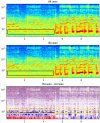https://www.mobile01.com/topicdetail.php?f=348&t=6953606
Some people claim to be able to tell the difference between Ethernet cable
And passed ABXTEST
The reason may be due to the 60HZ hum(Data comes from smartphone recordings
 )
)
Is this a common situation or an extreme situation?
and Recording using smartphone
network cable use "AIM NA7"&"ordinary cable"
Then listen to the recorded file(abxtest)
can distinguish
AIM NA7 Website link
Then another one (Volf) use"LINKOMM Cat8" & "ordinary cat5"
Bluesound PowerNode + Focal Aria K2 906+ iphone15(for recording)
"LINKOMM Cat8" & "ordinary cat5"
Record 5 times each
get




A2 A3 A4 A5 has 60HZ HUM
B1 B2 B3 B4 B5 does not have 60HZ HUM
There is something abnormal about A1
Some people claim to be able to tell the difference between Ethernet cable
And passed ABXTEST
The reason may be due to the 60HZ hum(Data comes from smartphone recordings
Is this a common situation or an extreme situation?
Try my best to write a simple summary
goldbingo(author) use Lumin T1 + Heidelberg 120 Gold , ATC SCM11 Vand Recording using smartphone
network cable use "AIM NA7"&"ordinary cable"
Then listen to the recorded file(abxtest)
can distinguish
AIM NA7 Website link
Then another one (Volf) use"LINKOMM Cat8" & "ordinary cat5"
Bluesound PowerNode + Focal Aria K2 906+ iphone15(for recording)
"LINKOMM Cat8" & "ordinary cat5"
Record 5 times each
get
A2 A3 A4 A5 has 60HZ HUM
B1 B2 B3 B4 B5 does not have 60HZ HUM
There is something abnormal about A1
Attachments
Last edited:

